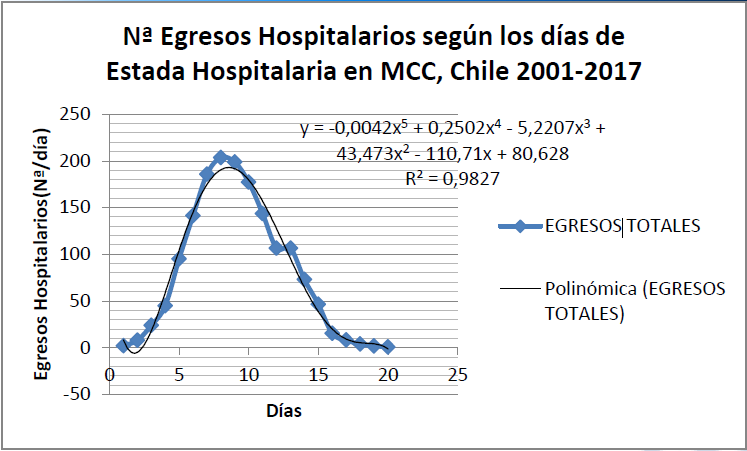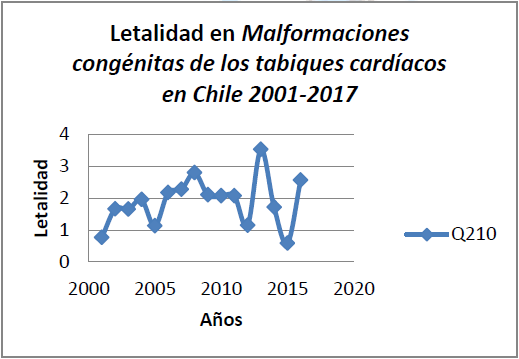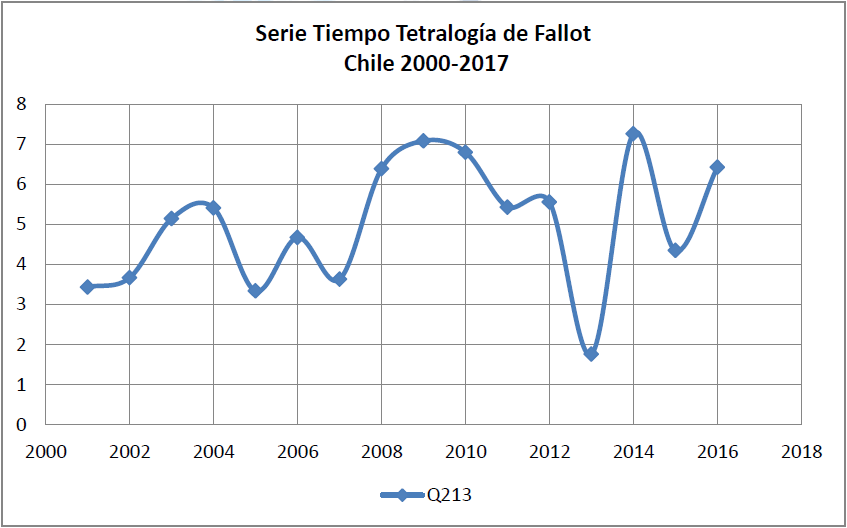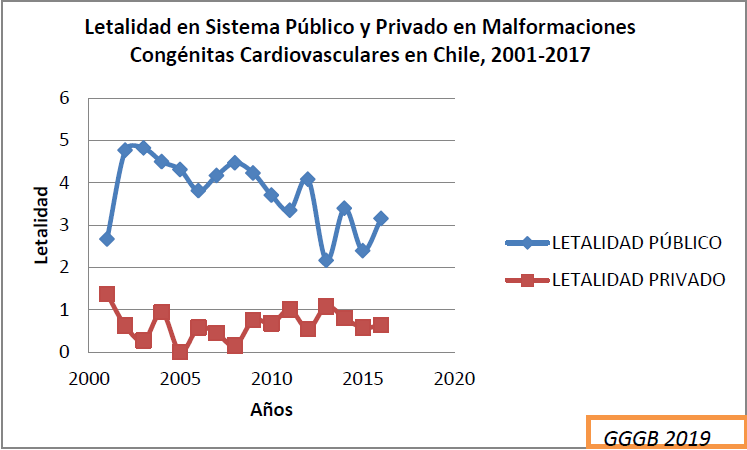Research Article
Volume 1 Issue 2 - 2019
Evaluation of the Impact of the Implementation of GES Public Policies on the Mortality of Surgeries in Children with Heart Malformations Between 2001 and 2017.
1Facultad Medicina, Universidad Finis Terrae, Chile
2Servicio de Medicina Interna, Hospital El Carmen de Maipú, Chile.
2Servicio de Medicina Interna, Hospital El Carmen de Maipú, Chile.
*Corresponding Author: Carlos Moore Valdés, Internal Medicine Hospital Valentin Ferrada Maipú, Av Camino La Rinconada 1203, Santiago, Región Metropolitana, Chile.
Received: September 05, 2019; Published: September 12, 2019
Abstract
Introduction: Prior to GES program initiation in 2002, congenital heart disease (CC) mortality accounted for 33% of deaths from congenital anomalies in children under 1 year of age. The GES seeks to increase the number of CC surgical treatments by streamlining the screening process and prenatal diagnosis of CC.
Objective: Assess how the GES has impacted lethality and mortality in CC surgeries, based on age, gender, days of stay, and forecast.
Methods: A case study and retrospective observational controls were conducted on 43024 hospital outflows of time series prais-weinstein analysis. Contingency tables were prepared with data on hospital egress, age, gender and forecast for 2001 and 2017. The Fisher Test was used p<0.05.
Results: In 2001, the average age was 8.7 years (IC-8.1-9.3), with no difference in mortality by sex (3.97% v/s 4.08%; P> -0,889). Odd's ratios associated with sex (0.971 higher than men v/s women) IC-0, 820-1.191; p-0.861>0.05; Age OR'S (0.981 per year ) IC-0.971-0.991; p<0.0001 OR'S Forecast (FONASA-5.814 IC 1.642- 20.589 that the private ISAPRE, DIPRECA, CAPREDENA System; confirmed our research hypothesis Mortality was lower in the group undergoing surgery (OR 1,279; IC-0,8596-1,922), with a death RR of 1.01 (IC-0.9937-1,025).
Higher mortality occurs in the public sector (2.66% v/s 1.36%; p<0.001), which increased for 2016 (3.11% v/s 0.81% p-0.1273).
Discussion: This study observed a statistically significant difference in CC mortality as expected for 2001 (pre-GES), which ceased to be the case in 2016. GES reduced CC mortality from 33% to 4.02% in deaths from congenital anomalies.
Keywords: Congenital heart diseases; Equity; Health care; Public health policies & guarantees.
Abbreviations
MCC = Congenital Cardiovascular Malformations; GES = EXPLICIT GUARANTEES IN HEALTH; FONASA = NATIONAL HEALTH FUND; ISAPRE = INSTITUTIONS FORECAST HEALTH; DIPRECA= Directorate of Forecasting of Chilean Policemen (Dipreca); CAPREDENA= National Defense Forecast Fund.
Introduction
In Chile, congenital cardiovascular malformations account for 26.7% of all malformations in new born children, accounting for 20% of neonatal deaths and about 50% of infant deaths. This impact has its origins in the creation of the National Health Service in the 1960s, reducing infant mortality as a maternal, through the institutionalization of childbirth, perinatal care and the improvement in access to basic services and food in the population. Despite the above, the incidence of congenital malformations has been on the rise over the past 20 years associated with decreased birth [1], postponement of motherhood [2], the increase in the prevalence of chronic diseases such as diabetes and increase in high-risk drug use [3].
The GES benefit program created in 2002 generated a clinical guide in 2005 updated in 2010, which sets the times for diagnosis based on suspicious, which are configured as follows: pre-natal (20 or more weeks of gestation), within 30 days of medical indication; 0 to 7 days of extra uterine life, within 48 hours from suspicion; From the age of 8 days and under 2 years, within 21 days from suspicion; and between the ages of 2 and under 15, within 180 days of suspicion. It further states through its guarantee of opportunity that the time from diagnosis to treatment should be performed within the following deadlines: Severe ooperable congenital cardiomyopathy: Entry to provider with surgical resolution capacity, within 48 hours from patient stabilization; other operable congenital heart disease: treatment as directed; Control: within the first year from discharge. [2]
The objective of this study is to assess the impact of the GES benefit programme on the letality and intra hospital mortality of hospital discharges between the periods prior to GES 2001-2005 and POST GES 2006-2017, and its relationship to the forecast system in age, sex and days being hospitalized.
Materials and Methods or Experimental Procedures
Study in 43024 hospital egress design of analytical, longitudinal and observational type. The databases from the website were used www.deis.cl dated 4 in January 2018 to carry out this study. Before entering them, the CIE 10 coding manual was reviewed by verifying that the variable encoding was adequate. To do this, the number of incomplete data (17) was counted, leaving out all those individuals graduated from a hospital that did not provide information of the planned type and those cases where the forecast was not reported. A one-variate statistical analysis was carried out in order to evaluate the population studied, consisting of hospital expenses for heart malformations in Chile, 2001-2017 using Excel.2013 software, in order to see the type of age distribution, sex and prognosis. He applied the Distribution Tests for Smirnov-kolmogorov and Poisson to assess the distribution of hospitalization days and ages. Subsequently, the data were grouped according to the forecast into two large groups: public (FONASA No. 1) and private (ISAPRE, PARTICULAR, DIPRECA and CAPREDENA No. 2) in order to evaluate the statistically significant differences between the two groups using the contrast test of Fisher's exact hypothesis to evaluate both groups, then applying the binary logistic regression model by calculating the ORs for both groups based on age, gender, forecast, surgery, and days of stay Hospital. It was considered statistically significant p < 0.05. To assess changes in lethality and hospital mortality, a time series analysis of prais-weinstein was carried out, the construction of an auto-regression function for the period 2001-2005 and 2006-2017, determining regression coefficients and to determine the secular trend or reject it with a value of 0.1 and a p < 0.05, all hospital discharges were considered during the year 2001 to 2017 with the diagnosis Q20.0-Q28.9, dividing it into two cohorts 2001-2005 and compared to the diagnosis q20.0-q28.9, dividing it into two cohorts 2001-2005 and compared to the public and the private forecast to see if there were statistical differences between the two groups. Consequently, our research hypothesis is that there is greater lethality and specific mortality in relation to surgical interventions between public and private systems.
Results and Discussion
When performing the GES regression model, a significant time-time interaction was observed with respect to the constant observing an interruption in trend 0.974391 p< 0.000. For the period 2001-2005, an increase in lethality and mortality was observed at a rate of 0.45 per year prior to the start-up of Ges and an obvious decrease in the post-Ges period at a rate of -0.873 per year, according to the following model of autoregression n G (t) to 0.453 3081* T (Preges) +8.313047 -0.8731766* T (PostGes) +1760.45 for congenital malformations of heart chambers and their connections; for the Transposition of Large Ships G (t) to 0.4533081* T (Preges) +8.313047 -0.8731766* T (PostGes) +1760.4 (Q21) Congenital Malformations Cardiac Septa G(t) - 2.536714* T (Preges) +1.997447 -1.258831* T2 (Post Ges) - 0.1859821* T3 (Post Ges) within this we highlight the tetralogy of Fallot G (t) Tetralogy of Fallot to 0.217176* T (Preges) - 0.538608* T2 (PostGes) + 1.182893; As for the days of hospital stay in the public sector, 9.89 v/s 7.24 days p< 0.05 preges for post-ges were higher than the private sector, which increased by slightly 10% in the public sector and a 1.4% reduction in the private sector in the private sector . The trend in behaviour in the lethality of the public sector was due to a slight reduction in mortality G (t) -0.043* T +1,677, with respect private.
During 2001, 49.29% were observed for men and 50.71% of women, with an average age of 8.7 years of HF (8.1-9,3) years of which no differences in intra hospital mortality according to sex were observed when the test was taken Fisher, being very similar to each other 3.97% vs. 4,08%; P>-0.889>0.01 not significant. The relative risk associated with dying from surgery is 1.01; IC 0.9937 to 1,025 being insignificant given the lower mortality in the group of those exposed by surgery., which would show greater survival in patients who are involved in a timely manner. The same was observed when carrying out the odds ratios whose values yielded 1,279; with confidence interval -0.8596 to 1,922; those distributed according to the forecast by 55.66% were in the public sector and 44.34% to the private sector consisting of 33% Isapre, 2% Dipreca and 1% Capredena. Statistically significant differences in egress status were found with respect to forecasting, with a mortality ratio of 2.66% in the public sector against 1.36% in the private sector with p30.001 when conducting the exact test of Fisher, what confirmed our research hypothesis vs. 2016 public sector 3.11% vs. 0.81% private sector p.0.1273>0.001; not statistically significant despite its value.
Statistically significant differences in egress status were found from forecasting during 2017, with a mortality rate of 2.67% in the public sector versus 1.37% in the private sector with p < 0.05 when performing Fisher's exact test. Odd's ratios associated with sex (0.971 higher than men v/s women) IC-0,820-1.191; p-0.861>0.05; Age OR'S (0.981 per year) IC-0.971-0.991; p< 0.0001 Or'S Forecast (FONASA-5.814 IC 1.642- 20.589 that the private ISAPRE, DIPRECA, CAPREDENA system; confirmed our research hypothesis.
| Variables | Hospitales Público | Hospitales Privado | Odds Ratios |
| Sexo | Masculino: 2012 (49%) Femenino: 2107 (51%) |
Masculino: 3477 88, 82% Femenino: 528 (13, 18%) |
0.971 (0.820-1.191) (p>0.861) |
| Previsión | FONASA 83.17% (31912) | ISAPRE16,83% 6458 | 5.814 IC=1.642-20.589 p<0.001) |
| Edad | 63,752+-12, 58 | 62,07+-13,25 | 0.981-(0.971-0.991) per year p<0.001) |
| NSE | Letra A=9,51% B=31,5% C=6,67% D=17,67% |
ISAPRE=20,4% DIPRECA=2,5% CAPREDENA=1,2% PARTICULAR=4,67% |
|
Fig1. Health care in Chile PreGes Post Ges Cardiac Malformations outbreaks in Chile 2001 2017.

Figure 1: Descriptive table of the composition of the Public and Private health system according to the Provision for hospital discharges of Congenital Cardiovascular Malformations Chile 2001 2017.

Figure 2: Poisson distribution in the outbreaks days both in Public and Private hospitales como en Chile 2001 a 2017.

Figure 3: Lethality and time series in children with malformations with defects of the cardiac chambers and their connections. A trend break after the year 2005 2017 was observed with a significant reduction in lethality in the 2005 2010 interval and its subsequent elevation between 2010 and 2017.

Figures 4, 5, 6: The trend of behavior in the lethality of the public sector tended to a slight reduction in mortality G (t) = 0.043 * T +1.677. But a global increase in pathology Tetralogy of fallot of 3.8% per year p = 0.003 and lethality of 4.3 to 5.38% between the periods preges and post ges.

Figure 7: In relation to the OR’S Forecast (FONASA 5.814 IC 1.642 20.589 that the private system ISAPRE, DIPRECA, CAPREDENA; a progressive increase per year was observed in the interval from pre ges to postges.
Conclusion
Auth With regard to differences between public and private hospital establishments according to the number of professionals [4], coverages [4] and morbidities [5], considering the heterogeneity of Chile's health system [6] differences are evident between public and private establishments, including user perception [7]. This study found that there are statistically significant differences in egress status between the public-private system in relation to mortality and an ostensible reduction from 2001 to 2017, however there is an increased risk of passed away between the public system over private.
References
- Mayorga H Carla, Rodrí guez A Juan Guillermo, Enrí quez G Gabriela, Alarco n R Jaime, Gamboa W Constanza, Capella S Daniela et al . (2013). Congenital cardiopathies: prenatal diagnosis and follow-up. Revista chilena de obstetricia y ginecología.
- Ministry of Public Health of Chile. Clinical guide to operable congenital heart disease in children under 15 years of age. Santiago, 2010.
- Herna n Mun oz, Yazmin Copado, Carlos Dí az, Gianna Mun oz, Gabriela Enrí quez, Susana Aguilera, (2016).DIAGNÓSTICO Y MANEJO PRENATAL DE PATOLOGÍA CARDÍACA FETALPRENATAL DIAGNOSIS AND MANAGEMENT OF FETAL CARDIAC DISEASE, Revista Médica Clínica Las Condes 27.4: 447-475.
- Nazer H Julio, Aravena C Teresa, Cifuentes O Lucia. (2001). Malformaciones congénitas en Chile. Un problema emergente (período 1995-1999). Revista médica de Chile 129(8): 895-904.
- Alejandra Zu n iga Fajuri. (2011). Justice and Health Rationing in the AUGE Plan: bioethical dilemmas associated with the distribution of scarce resources.. Acta Bioethica ; 17 (1): 73-84, 2011.
- Dipierri JE, Acevedo NE, Bronberg RA. (2015). Child mortality from congenital malformations in Chile: temporal and spatial analysis, 1997–2011. Rev Panam Public Health. 38.5: 380-387.
- Ministry of Health. Undersecretary of Assistance Networks. Assistance Network Management Division (2005). Comprehensive Health Care Model. Series Model Attention Notebooks No. 1.
- Walker, R., Montero, L. (2004). General Principles of Adult Education. Chilean Journal of Family Medicine 5 (2): 65-71.
Citation: Gustavo Gómez Barbieri, Richard Von Moltke, Ernesto Vega Asún and Dr Carlos Moore Valdés. (2019). Evaluation of the Impact of the Implementation of GES Public Policies on the Mortality of Surgeries in Children with Heart Malformations Between 2001 and 2017. Journal of Medical Research and Case Reports 1(2).
Copyright: © 2019 Carlos Moore Valdés. This is an open-access article distributed under the terms of the Creative Commons Attribution License, which permits unrestricted use, distribution, and reproduction in any medium, provided the original author and source are credited.


